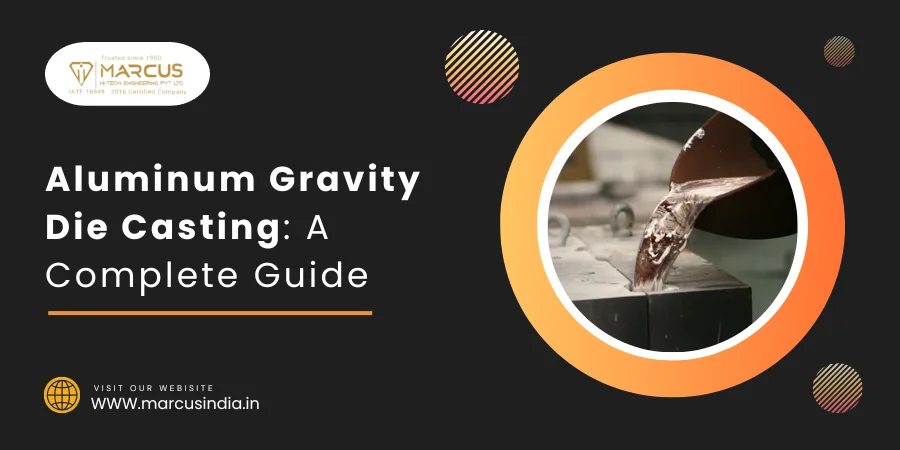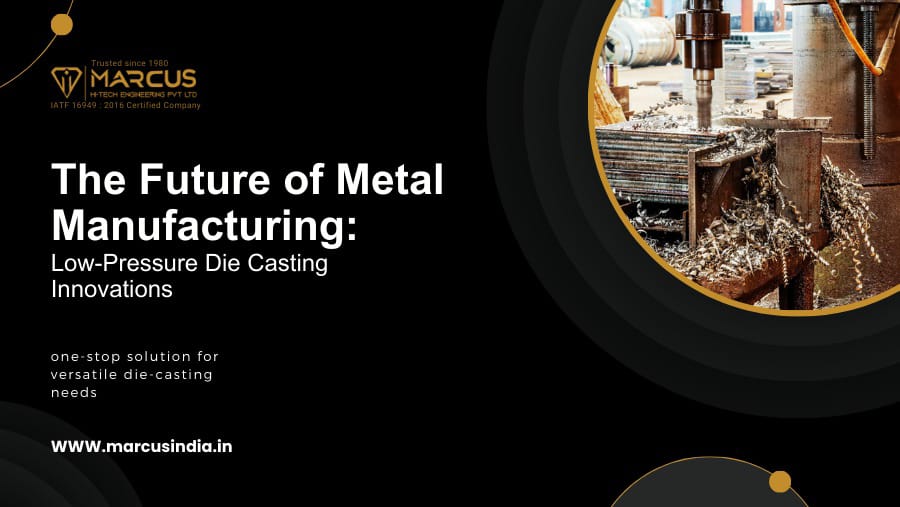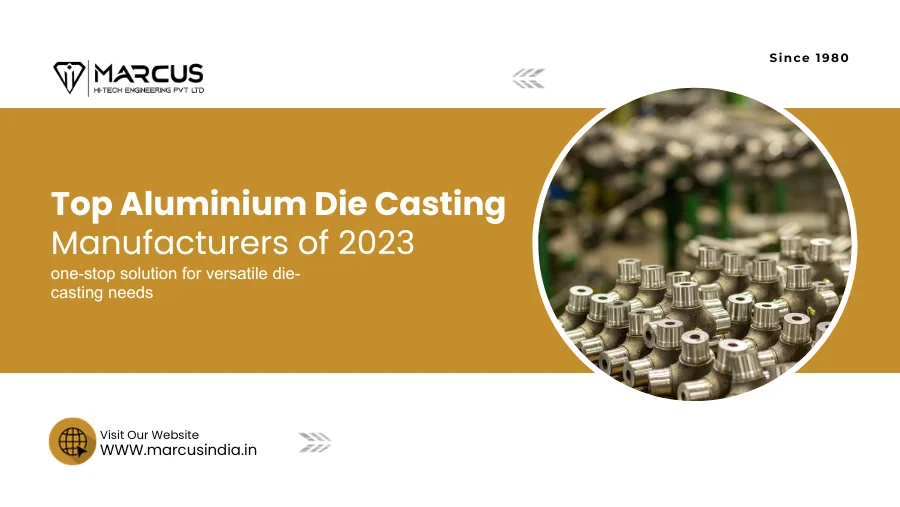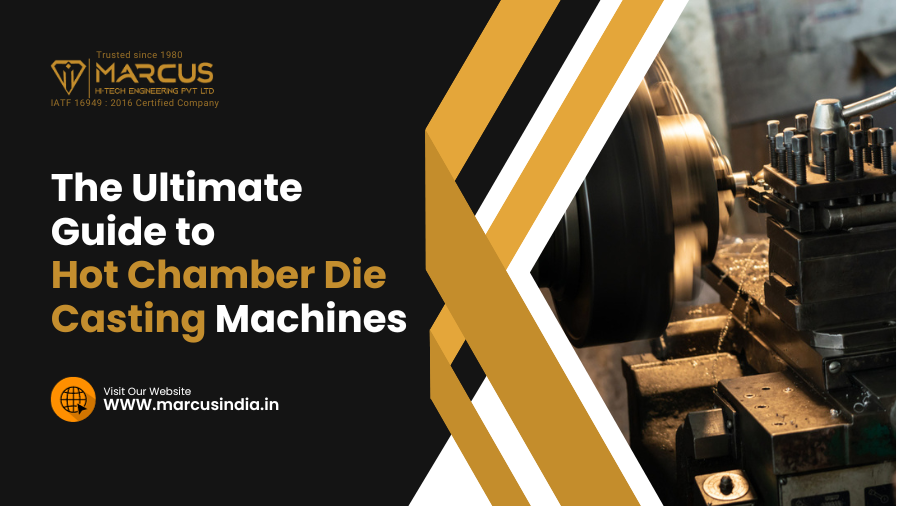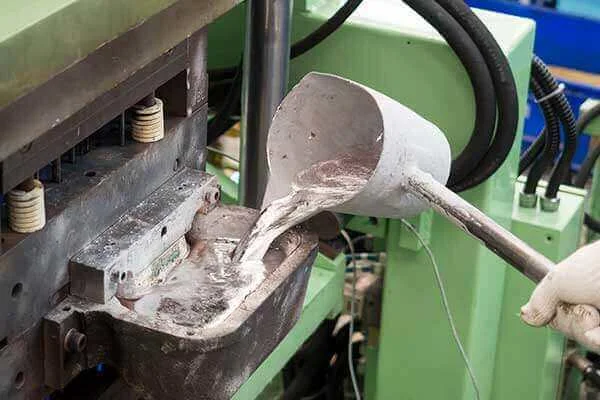
Almost everyone is familiar with the popularity of aluminum concerning its usage in the world of manufacturing and metal casting. It is a widely used material due to its excellent properties. With many manufacturing units using Aluminum due to its high-strength-to-weight ratio, corrosion resistance, and thermal conductivity, the importance of this chemical element cannot be overstated!
Aluminum gravity die casting is a widely used technique in automotive parts production. It allows the production of complex and intricate aluminum parts with high precision.
This comprehensive guide will guide you through the process of aluminum gravity die casting and discuss its advantages in various industries.
Understanding Aluminum Gravity Die Casting
Permanent mold casting or aluminum gravity die casting is a process that involves pouring molten aluminum alloy into a mold, allowing it to solidify, followed by extracting the cast or part once it has cooled. The mold used here is a reusable steel or cast iron vessel. Unlike sand casting processes that use expendable molds, gravity die casting employs a permanent mold that can be used repeatedly in every process, helping you save costs and increase production efficiency.
Gravity die casting relies on gravity to fill the mold rather than any external force, pressure, or vacuum. This process commonly casts non-ferrous metals like aluminum, copper, and magnesium alloys.
Aluminum Die Casting- The Process
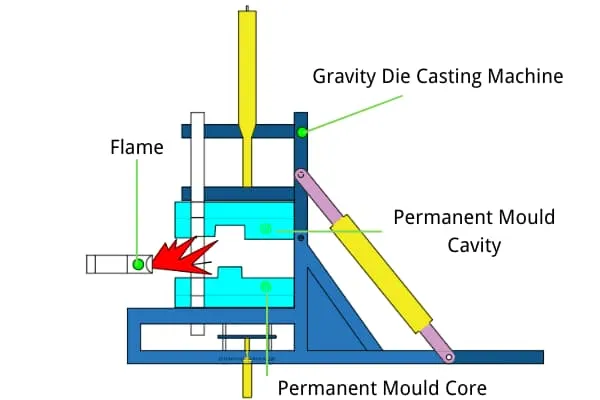
1. Fabrication of The Mold
The gravity die-casting process is nothing without a mold. The process begins with designing or fabricating the mold. Generally, the mold consists of two halves: the stationary half, the cover die, and the movable half, commonly called the ejector die. When bought together, these two halves form the mold cavity. While designing the mold, one must consider some essential factors like part geometry, draft angles, and proper gating and rising systems to establish a successful casting process.
2. Preparing the Mold
Now that you have successfully finalized the mold design, it’s time for its preparation. Use a suitable release agent to clean and coat the mold surfaces. This ensures the molten aluminum doesn’t stick to the mold. The release agent helps ensure easy removal of the solidified casting from the mold after the casting process.
3. Preheating the Mold
You can only solidify molten aluminum by properly preheating the mold. It must be preheated to a specific temperature before pouring the chemical element. Preheating helps ensure better metal flow, reduces solidification time, and enhances the casting quality. The preheating temperature can be determined depending on the type of aluminum being cast and the size and complexity of the component.
4. Pouring the Molten Aluminum
After preheating the mold, the molten aluminum is poured into its cavity. Typically, the metal undergoes heating in a furnace until it reaches the desired casting temperature. It is then transferred to a spoon or pouring system to pour into the mold precisely. The pouring process requires careful control of the temperature and flow rate to guarantee the mold cavity is adequately filled and to avoid defects such as cold shuts or misruns.
5. Solidification and Cooling
Once the molten aluminum is poured into the mold, it begins to solidify, conforming to the shape of the mold cavity. The solidification process is affected by various factors, including the composition of the alloy, the rate at which it cools, and the design of the casting itself. Cooling channels integrated within the mold extract heat from the casting, promoting solidification. Once the casting has adequately solidified, it is extracted from the mold.
6. Casting Removal
Now comes the ejecting! During gravity die casting, the ejector die is employed to push the casting out from the mold cavity. Subsequently, the casting is separated from the sprue, runner, and any other gating system that may be present. Handling the removal process carefully is crucial to prevent any harm or damage to the casting.
7. Finishing
Like every product, the cast part also needs finishing touches. The finishing operations are executed to achieve the desired final shape, surface finish, and dimensional accuracy. These processes may include trimming excess material, grinding, sanding, shot blasting, or heat treatment processes like aging or solutionizing.
8. Inspection & Quality Control
The castings undergo a comprehensive inspection to verify their compliance with the specified requirements and quality standards. Multiple inspection methods, including visual examination, dimensional measurements, and non-destructive testing, are utilized to identify defects or inconsistencies. Based on the issue’s severity, defective castings can either undergo repair or be discarded accordingly.
Advantages of Aluminum Gravity Die Casting.
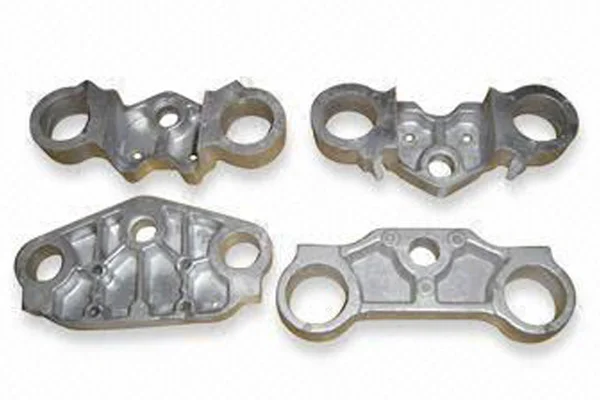
Let us understand why aluminum gravity die casting has become a popular solution for manufacturers worldwide:
1. Superior Casting Quality
Aluminum gravity die casting can manufacture top-notch components with superior dimensional accuracy and surface finish. This production process entails the pouring of molten aluminum into a durable steel mold using the force of gravity. By employing this method of controlled pouring, turbulence is minimized, effectively preventing the formation of air pockets and porosity.
As a result, the components produced possess outstanding surface finish and structural integrity. The inherent stability of the mold guarantees consistent quality from part to part, making aluminum gravity die casting highly suitable for applications that demand precise tolerances.
2. Design Flexibility
Utilizing permanent steel molds enables the fabrication of components with intricate shapes, delicate features, and complex geometries. Manufacturers can harness this design flexibility to produce parts with thin walls and intricate details. This capability opens up vast possibilities for creating lightweight yet robust components, minimizing r additional operations and assembly. Requirements Aluminum gravity die casting empowers manufacturers to realize intricate designs that are otherwise difficult to replicate using alternative casting techniques.
3. Cost-Effective Production
Aluminum gravity die casting presents various cost advantages throughout the production process. To begin with, the molds employed in this method have a prolonged lifespan, enabling multiple production runs while maintaining consistent quality. This increased durability contributes to lower tooling costs and enhances the overall cost-effectiveness of the casting process. Moreover, the rapid solidification rates of aluminum alloys used in gravity die casting result in shorter cycle times, boosting productivity and reducing manufacturing costs. Additionally, the capability to produce net-shaped or near-net-shaped components eliminates or minimizes the necessity for additional machining, resulting in time and cost savings.
4. Material Efficiency While Ensuring Environmental Sustainability
Optimizing material utilization is vital in manufacturing, and aluminum gravity die casting excels. This casting method utilizes gravity to fill the mold, resulting in minimal material waste and precise metal distribution. The efficient use of materials leads to cost savings and a reduced environmental footprint. Additionally, aluminum is highly recyclable, enabling manufacturers to recycle and reuse excess material or scrap generated during the casting. The combination of effective material utilization and recyclability makes aluminum gravity die casting an environmentally sustainable option.
5. Heat Dissipation & Mechanical Properties
Aluminum’s remarkable thermal conductivity makes it a superb material choice for applications that demand efficient heat dissipation. Aluminum gravity die casting enables the fabrication of components with intricate cooling channels and fins, optimizing heat transfer in applications like heat exchangers or engine components. Furthermore, aluminum alloys used in gravity die casting exhibit favorable mechanical properties, including high strength, excellent corrosion resistance, and lightweight attributes. These properties render aluminum gravity die-cast components well-suited for diverse industries, including automotive, aerospace, and electronics.
Commonly Used Aluminum Alloys in Gravity Die Casting
The selection of aluminum alloy is a crucial determinant of the effectiveness of gravity die casting. Now, let’s delve into some frequently employed aluminum alloys in gravity die casting, their characteristics, and the industries in which they are commonly utilized:
1. A356 Aluminum Alloy
A356 is an alloy that can be treated with heat and is mainly made up of aluminum, silicon, and magnesium. It possesses a remarkable ability to be cast, favorable mechanical characteristics, and a high level of resistance to corrosion. It finds widespread application in the automotive sector, where it is used for manufacturing different parts, including engine blocks, cylinder heads, and transmission cases.
2. ADC12 Aluminum Alloy
ADC12 is a non-heat-treatable alloy with aluminum, silicon, and other trace elements. It exhibits good casting fluidity, excellent machinability, and high strength. This alloy is commonly used in the production of electrical housings, automotive parts, and various consumer goods.
3. 380 Aluminum Alloy
The 380 aluminum alloy is extensively utilized in gravity die casting due to its exceptional casting properties. It is predominantly composed of aluminum, with the addition of silicon and copper. The 380 alloy exhibits fluidity, corrosion resistance, and favorable mechanical properties. It finds widespread application in producing pump housings, valve bodies, and other components that demand high strength and dimensional stability.
4. 413 Aluminum Alloy
The 413 aluminum alloy is versatile for gravity die casting in various applications. It is a heat-treatable alloy of aluminum, silicon, and copper. With excellent strength, wear resistance, and machinability, the 413 alloy is commonly employed in manufacturing aerospace components, marine equipment, and structural parts across diverse industries.
5. 356 Aluminum Alloy
356 is a widely utilized aluminum alloy known for its outstanding casting abilities and mechanical characteristics. It is composed of aluminum, silicon, and various minor elements. 356 exhibits favorable flowability, remarkable strength, and exceptional corrosion resistance. It is extensively applied in the automotive sector, particularly for manufacturing components such as wheels, intake manifolds, and brackets.
6. 319 Aluminum Alloy
The 319 aluminum alloy is widely favored for gravity die casting due to its remarkable castability and favorable mechanical properties. It is predominantly composed of aluminum, including copper and other minor elements. The 319 alloy exhibits excellent corrosion and moderate strength and is commonly employed in manufacturing pump housings, electrical connectors, and hydraulic components.
7. 535 Aluminum Alloy
535 is a heat-treatable aluminum alloy frequently used in gravity die casting. It primarily comprises aluminum, magnesium, and additional trace elements. This alloy exhibits outstanding machinability, good strength, and remarkable wear resistance. 535 is widely applied in diverse industries such as aerospace, automotive, and marine, where it is utilized for manufacturing components like gears, bushings, and valves.
Design Guidelines
1. Understand the Gravity Die Casting Process
To begin understanding design guidelines, it is crucial to comprehend the gravity die casting process. Gravity die casting entails pouring liquid aluminum into a metal mold, allowing gravity to facilitate the flow. As the mold gradually cools, the molten metal solidifies and takes on the intended shape. Acquainting yourself with this process empowers you to make well-informed design choices.
2. Optimize Wall Thickness
Ensuring a successful casting relies heavily on maintaining a uniform wall thickness. Thick sections tend to solidify slower, which can cause uneven cooling and heightened porosity. On the other hand, thin sections may solidify too quickly, leading to incomplete mold filling. It is advisable to strive for consistent wall thickness throughout the component, minimizing abrupt changes whenever feasible.
3. Consider Draft Angles
Including draft angles in the design safeguards both the component and the mold. Maintaining a minimum draft angle of 1-2 degrees is recommended. However, higher draft angles may be required to ensure proper functionality and prevent damage to textured or intricate surfaces.
4. Fillet and Radii
It is important to avoid sharp corners and edges in the design is essential to prevent defects or premature failure. Stress concentration tends to occur in such areas. By incorporating fillets or radii, the stress distribution is improved, thereby enhancing the overall strength of the casting. Aiming for a minimum 2-3 mm radius on all internal and external corners is recommended to achieve optimal results.
5. Parting Line Placement
The parting line, which marks the division between the two halves of the die mold, can be strategically positioned to achieve several advantages. By carefully selecting its location, the complexity of the mold design can be minimized, leading to reduced manufacturing costs and a simplified ejection process. It is crucial to choose a parting line placement that ensures optimal mold filling and facilitates easy removal of the casting.
6. Gate Placement and Design
The gate is the entry point for introducing molten aluminum into the mold cavity. The gate placement is vital in achieving thorough mold filling and minimizing defects like porosity and turbulence. Positioning the gate at the thickest section of the component is recommended to ensure uniform packing. The gate’s size, shape, and location should be determined by considering the part’s geometry and the properties of the casting material.
7. Ribs and Bosses
Ribs play a crucial role in reinforcing the strength of the casting, whereas bosses serve as attachment points for fasteners. When integrating ribs or bosses into the design, it is vital to ensure they are appropriately designed to maintain a consistent wall thickness and avoid sudden transitions. Tapering the ribs and bosses is recommended as it promotes solidification and helps minimize stress concentrations.
8. Material Selection
It is essential to make an informed choice of aluminum alloy to achieve the desired mechanical properties and casting performance in gravity die casting. Several factors should be considered when selecting the appropriate alloy, and several factors should be considered, including strength, corrosion resistance, heat conductivity, and casting fluidity. It is advisable to seek guidance from material experts or casting specialists to determine the most suitable alloy for your application.
9. Surface Finishes
Gravity die casting is renowned for its capability to manufacture components with outstanding surface finishes. However, specific design factors can further improve the final appearance. It is advisable to reduce the utilization of textured or intricate surfaces, as they can complicate the mold release process and impact surface quality. If textured surfaces are essential, it is recommended to collaborate closely with the mold maker to ensure appropriate mold design and the implementation of suitable finishing techniques.
10. Design for Manufacturability
Engaging with experienced gravity die casting suppliers or foundries during the design process’s initial stages is beneficial for obtaining valuable insights and feedback. Collaborating with these experts allows for identifying potential issues, offering suggestions for improvement, and optimizing the design to ensure cost-effective production. By involving them early on, their expertise can be leveraged to enhance the overall outcome of the casting project.
Emerging Technologies and Materials for Aluminum Gravity Die Casting
With the constant advancement of technology and the demand for enhanced performance, there has been a surge in the development of emerging technologies and materials for aluminum gravity die casting. This section discusses some of these exciting innovations and their potential impact on the industry.
1. 3D Printing for Mold Manufacturing
The conventional approaches to mold manufacturing in gravity die casting have long been associated with arduous and costly procedures. Nevertheless, the emergence of 3D printing technology has brought about a groundbreaking transformation in this particular realm of the casting process. Additive manufacturing now enables the fabrication of intricate molds boasting intricate designs, drastically diminishing both time and expenses. By harnessing the power of 3D printing, manufacturers can fashion personalized molds tailored precisely to meet their specific demands, ultimately resulting in enhanced casting quality and accelerated production cycles.
2. Advanced Simulation Software
In recent years, simulation software has advanced significantly, empowering engineers to forecast and evaluate the behavior of molten aluminum throughout the casting process. This cutting-edge technology facilitates the optimization of critical factors, including mold filling, solidification patterns, and cooling rates. Through the simulation of diverse scenarios, manufacturers can pinpoint potential defects by simulating various systems and proactively implementing corrective actions before physical prototyping. This approach saves time, minimizes material wastage, and elevates the overall quality of castings.
3. High Thermal Conductivity Mold Materials
Effectively managing heat transfer between molten metal and the mold poses a significant hurdle in aluminum gravity die casting. Conventional molds constructed from materials like cast iron or steel frequently need help efficiently dissipate heat, leading to casting defects. Nevertheless, emerging materials, such as copper alloys or composite materials infused with graphite, present a promising solution. These innovative mold materials exhibit enhanced thermal conductivity, allowing for improved cooling rates, mitigated porosity risks, and attaining superior surface finishes.
4. Enhanced Surface Treatments
In numerous industries like automotive, aerospace, and consumer goods, the quality and appearance of the final cast product hold immense significance. Advanced surface treatment technologies, such as plasma electrolytic oxidation (PEO) and physical vapor deposition (PVD), have emerged as valuable solutions. These treatments offer enhanced surface hardness, corrosion resistance, and aesthetic appeal, extending the cast components’ lifespan and expanding their applications to a broader range of industries.
5. Intelligent Process Monitoring and Control
The progress in sensor technologies and data analytics has opened up new possibilities for intelligent process monitoring and control systems. Through real-time data collection and analysis, manufacturers can closely monitor vital parameters throughout the casting process, including temperature, pressure, and vibration. These systems can automatically fine-tune process parameters by incorporating feedback loops to optimize quality and productivity. Intelligent process control minimizes human error, reduces downtime, and enhances operational efficiency.
6. Alloy Development for Enhanced Properties
Extensive advancements have been made in aluminum alloys in pursuing enhanced mechanical properties like strength, hardness, and lightweight attributes. Manufacturers achieve this by meticulously selecting alloying elements and optimizing their proportions, allowing casting properties to be customized to meet precise application demands. For instance, incorporating magnesium or silicon into aluminum can significantly elevate its strength while preserving excellent castability.
Also Check: Techniques to Optimize Heat Treatment in Aluminium Die Casting
Over to You!
Aluminum gravity die casting represents a flourishing segment within the manufacturing industry. Even the studies show that during the forecast period of 2019-2024, the global gravity die casting market is projected to experience a compound annual growth rate (CAGR) of 3.41%. This growth can be attributed to the increasing demand for lightweight and cost-effective components from various industries, particularly the automotive sector.
Employed across various sectors, this process enables the production of metal parts with a wide range of shapes, including intricate designs. Compared to alternative manufacturing methods, die casting stands out with its rapid production rate, yielding exceptional quality and precision components.
As a key player in the industry, Marcus has contributed significantly with its extensive aluminum gravity die casting expertise. Their commitment to material sciences, process optimization, and innovation has played a pivotal role in advancing the technology associated with gravity die casting.
FAQs
Die casting is a manufacturing process where high-pressure forces molten metal into a mold cavity. The metal cools and solidifies, taking the shape of the mold. The mold is then opened, and the newly formed metal part is ejected.
Several finishing options are available for die-cast parts, including painting, plating, anodizing, and powder coating. These finishing options can help improve the appearance and durability of the parts and provide additional protection against corrosion and wear.
Marcus has a comprehensive quality control system in place to ensure that all parts produced meet or exceed customer requirements. This includes rigorous testing and inspection throughout the production process and ongoing monitoring and evaluation of quality metrics.
Yes, Marcus can provide custom tooling for die-casting projects. The company has in-house tooling capabilities and can work with customers to design and manufacture custom molds and tooling to meet their specific needs.
Marcus offers a range of design support services for die-casting projects, including design for manufacturability (DFM) analysis, 3D modeling, and prototyping. The company’s team of experienced engineers can work with customers to optimize their designs for the die-casting process and ensure that parts can be produced efficiently and effectively.


